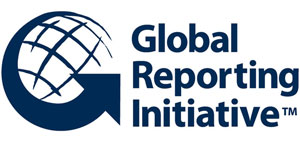Sustainability reporting is a marketing instrument. In order to enhance their image, companies pride themselves on reporting on their environmental and social impact in accordance with the GRI Guidelines. The Guidelines of the Global Reporting Initiative are the leading standard of sustainability reporting worldwide and Application Level A is the highest stage of the system. To get it, companies are expected to report to the fullest extent and have this application level checked and confirmed by GRI.
 But what lies behind this shining surface? To find out, a small team at TI Germany analysed the sustainability reports of 21 major German companies which all are oriented to the GRI Guidelines (version 3.0 or 3.1) and have declared Application Level A (or A+). They all are among the 40 best reports in a ranking sponsored by the German government.
But what lies behind this shining surface? To find out, a small team at TI Germany analysed the sustainability reports of 21 major German companies which all are oriented to the GRI Guidelines (version 3.0 or 3.1) and have declared Application Level A (or A+). They all are among the 40 best reports in a ranking sponsored by the German government.
First we looked at the GRI Content Indexes accompanying the reports. These are lists of the disclosures required by the Guidelines where the companies have to indicate for each disclosure whether it is fully, partially or not answered by the report and to refer to the page where the information for answering the disclosure can be read. The choice of Application Level A implies in principle the obligation to give the full information required by the Guidelines. In case no information or only partial information is given on a disclosure, the Index has to explain the reason for the omission. This is the principle of report or explain.
We focused the disclosure of information about incidents of corruption, anti-corruption actions, risk analysis, training, public policy positions and lobbying. Out of the 84 indicators shown in the GRI Content Indexes (4 indicators (SO2, SO3, SO4, SO5) in the reports of 21 companies) we classified 72 had been classified as fully reported, 9 as partially reported and 3 as not reported. Out of the 12 cases not classified as fully reported, 5 failed to present the required explanation for the omission and thus did not comply with the principle of report or explain. We assessed this result as not satisfactory, but not all that bad.
The big surprise came when we went to the next step: We looked at the text bodies of the reports to find the actual information required by the Guidelines. We were stunned that only 18 indicators were fully reported upon – in contrast to 72 classified as fully reported in the GRI Content Indexes. In 13 cases the relevant topic was not mentioned at all – in contrast to only 3 shown as not reported in the GRI Content Indexes. Summarizing all findings, there was only one report which fully complied with the principle of report or explain ruling the choice of Application Level A.
These results had been verified by sending our assessments to the companies involved and inviting their comments. In a small number of cases we had had to adjust our data, and only 3 cases were left with diverging interpretations.
There was still another big surprise: 17 of the companies had sent their reports to GRI for the Application Level Check. GRI had confirmed that “the report fulfills the requirement of Application Level A“ and that “the required set and number of disclosures for that Application Level have been addressed in the reporting and that the GRI Content Index demonstrates a valid representation of the required disclosures, as described in the GRI Guidelines“. We sent the draft final report of our study to GRI and asked for their comment. In their response GRI explained that “GRI looks into a sample of the disclosures, i.e. not all disclosures, in the report and therefore some of the disclosures analyzed in your study may not have been included in the sample checks made by GRI.”
What does our study tell us? Of course, we have analyzed only a small section of the reports related to corruption and public policy, and the study had a very limited object of matching the reports with the disclosures required by the GRI Guidelines. Therefore our results cannot be representative for the overall quality of the reports. Nevertheless, they raise serious doubts about the diligence applied in compiling and checking the reports. Window-dressing seems to have an important impact. In particular we suggest that most companies are unwilling to reveal too many details in the field of (anti-)corruption and political influence. Altogether, we are left with the impression that these fields are widely neglected parts of sustainability reporting – both in the standards and in their implementation. While the GRI Guidelines present 30 core indicators in the field of environment, there are only 4 core indicators to cover the topics of corruption and public policy.
Currently, the next generation of the GRI Guidelines is being developed and public consultations took place to invite comments. In line with the TI secretariat we contributed to these consultations. Most importantly we asked to make reporting on anti-corruption and lobbying mandatory and to require expanded and more detailed information. Also we stressed the need for an effective reviewing process of the reports to assess that they are in accordance with the GRI Guidelines.















 Connect with us on Facebook
Connect with us on Facebook Follow us on Twitter
Follow us on Twitter